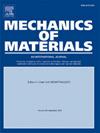Microscale model for intergranular and transgranular damage and fracture in polycrystalline ceramics
IF 4.1
3区 材料科学
Q2 MATERIALS SCIENCE, MULTIDISCIPLINARY
引用次数: 0
Abstract
Intergranular and transgranular fracture play a critical role in determining the fracture behavior and toughness of polycrystalline materials. These mechanisms are governed by microstructural features, including grain size, grain shape, grain crystallographic orientations, and grain boundary properties. We present a microstructure-explicit and fracture process-explicit model for elucidating the relationships between the fracture mechanisms, microstructural features, and macroscopic fracture behavior. This cohesive finite element method (CFEM) based model accounts for anisotropic grain constitutive and fracture behaviors and misorientation angle-dependent grain boundary fracture behavior, enabling the explicit resolution of complex crack paths and patterns. The material considered is Silicon Carbide (SiC), for which the model is calibrated using experimental and molecular dynamics data. Simulations under impact loading reveal dependencies of spall strength on grain size and grain shape. Specifically, the spall strength increases with grain size. The grain shape, characterized by the aspect ratio, also exhibits a strong influence on the spall strength, with grains elongated in the direction of impact loading providing up to two-fold increases in the spall strength over aspect ratios in the range of 0.2–10. Analyses reveal that the interplay between intergranular fracture and transgranular fracture is responsible for the observed trends. The promotion of transgranular fracture, particularly in grain fracture sites with high orientation-dependent fracture energies, is essential for the strength enhancement. The findings can be used to identify microstructural configurations that maximize the spall strength under specific conditions. The model presented can also be used to explore microstructure design of other ceramics and ceramic composites.
多晶陶瓷晶间和穿晶损伤断裂的微尺度模型
晶间断裂和穿晶断裂是决定多晶材料断裂行为和韧性的关键因素。这些机制是由微观结构特征决定的,包括晶粒尺寸、晶粒形状、晶粒结晶取向和晶界特性。为了阐明断裂机制、微观结构特征和宏观断裂行为之间的关系,我们提出了一个微观结构显式和断裂过程显式模型。基于内聚有限元方法(CFEM)的模型考虑了各向异性的晶粒本构和断裂行为以及与取向角相关的晶界断裂行为,能够明确地分辨复杂的裂纹路径和模式。考虑的材料是碳化硅(SiC),该模型使用实验和分子动力学数据进行校准。冲击载荷下的模拟揭示了颗粒强度与晶粒尺寸和晶粒形状的关系。具体来说,随着晶粒尺寸的增大,颗粒强度增大。以长径比为特征的晶粒形状对颗粒强度也有很大的影响,在0.2-10的长径比范围内,颗粒在冲击载荷方向上拉长,使颗粒强度增加了两倍。分析表明,沿晶断裂和穿晶断裂的相互作用是造成上述趋势的主要原因。促进穿晶断裂,特别是在具有高取向依赖断裂能的晶粒断裂部位,是增强强度的必要条件。研究结果可用于确定在特定条件下最大限度地提高剥落强度的微观结构构型。该模型也可用于探索其他陶瓷和陶瓷复合材料的微观结构设计。
本文章由计算机程序翻译,如有差异,请以英文原文为准。
求助全文
约1分钟内获得全文
求助全文
来源期刊

Mechanics of Materials
工程技术-材料科学:综合
CiteScore
7.60
自引率
5.10%
发文量
243
审稿时长
46 days
期刊介绍:
Mechanics of Materials is a forum for original scientific research on the flow, fracture, and general constitutive behavior of geophysical, geotechnical and technological materials, with balanced coverage of advanced technological and natural materials, with balanced coverage of theoretical, experimental, and field investigations. Of special concern are macroscopic predictions based on microscopic models, identification of microscopic structures from limited overall macroscopic data, experimental and field results that lead to fundamental understanding of the behavior of materials, and coordinated experimental and analytical investigations that culminate in theories with predictive quality.
 求助内容:
求助内容: 应助结果提醒方式:
应助结果提醒方式:


